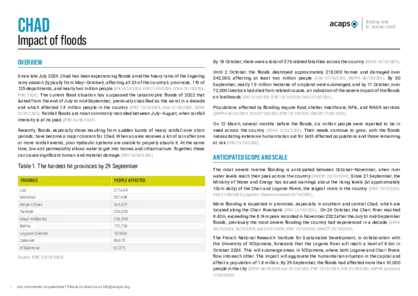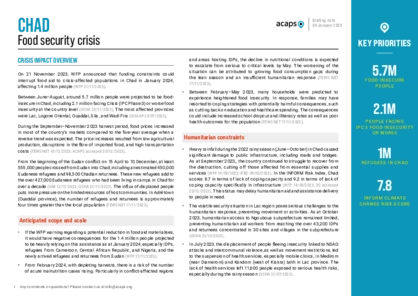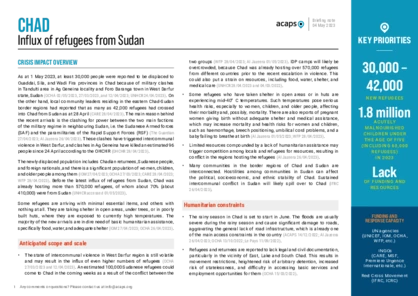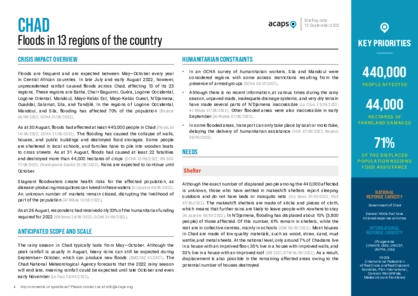Latest updates on country situation
16 December 2024
By 15 December 2024, over one million Sudanese refugees were registered in Chad, more than 719,000 of whom came after the start of the conflict in Sudan in mid-April 2023. The majority live in formal and informal overcrowded camps in Ennedi-Est, Ouaddai, Sila, and Wadi Fira provinces. These people need access to shelter, food, water, NFIs, healthcare, and education. (UNHCR accessed 18/12/2024, UNHCR 03/12/2024), WHO 25/11/2024)
30 October 2024
Clashes in West Darfur state, Sudan, have intensified, leading to a surge in the number of Sudanese refugees arriving in Chad. Since April 2023, over 680,000 Sudanese refugees have been displaced to Chad, with 49,000 arriving in October. Camps in Chad face severe overcrowding and shortages in food, water, and shelter. (IRC 28/10/2024, TNA 17/10/2024)
17 September 2024
The impact of widespread flooding from heavy rainfall since mid-July 2024 is heightening. Reports indicate that the floods had affected almost 1.5 million people across the 23 provinces by 17 September, killing 341 people, damaging at least 265,000 houses, submerging over 250,000 hectares of agricultural land, and restricting humanitarian access. Eight provinces (Batha, Guera, Lac, Logone Oriental, Mandoul, Mayo Kebbi Est, Salamat, and Tandjilé) are among the hardest hit, with about 1,179,000 people affected. With their livelihoods devastated, these people need shelter, health, protection, and food aid and assistance. The lack of access to WASH services aggravates the risks of a cholera epidemic across the country. (UNFPA 12/09/2024, UNICEF 17/09/2024, RFI 16/09/2024)
21 August 2024
Between 15 July and 15 August 2024, heavy rains and floods affected at least 261,000 people in Tibesti region, northwestern Chad, displacing more than 5,300 and damaging or destroying 16,200 homes. By 19 August, nearly 70 people had died from the impact. Floodwaters are preventing government and humanitarian responders from reaching some areas. The people living in these areas have not received humanitarian assistance, with planes likely the only means to reach them. The floods have also exposed unexploded mines that had been buried in the land from previous conflicts, making movement more dangerous. More rain is forecast for the following days, and the humanitarian situation is likely to worsen. There is a lack of information on the needs of the people affected and displaced, but they likely need food, NFIs, shelter, and clean drinking water. (ECHO 19/08/2024, OCHA 20/08/2024, RFI 19/08/2024)
06 August 2024
An assessment in Chad found that from mid-May to 1 August 2024, heavy rainfall affected 15,558 people and 4,642 houses across Batha, Chari-Baguirmi, Kanem, Lac, Logone Oriental, and Mayo Kebbi Ouest provinces. The impact has resulted in nine reported deaths, including three children, and blocked several roads, constraining access in the affected areas. The affected people need assistance in the form of shelter, food, essential household items, and WASH services. (ECHO 05/08/2024, OCHA 01/08/2024)
18 June 2024
By mid-2024, eastern Chad is hosting more than one million Sudanese refugees. About 604,000 have arrived since the outbreak of the conflict in Sudan in April 2023, including 107,000 since January 2024. They arrive in areas with limited natural resources and livelihood opportunities, where essential services are lacking. Their main needs include health services (including mental health assistance), protection, food, WASH, and shelter. The latter is crucial as the starting rainy season raises concerns about the risks of flooding. (WHO 18/06/2024, UNHCR 31/05/2024)
30 April 2024
Since March 2024, heavy rainfall has been affecting the southern provinces of Logone Oriental and Mandoul, causing floods as rivers overflow. As at 30 April, the disaster had killed one person and injured 45 others. The authorities report about 3,700 affected people (650 households), 692 collapsed houses, 20 damaged classrooms, about 2,000 sacks of cereals destroyed, 130 heads of cattle missing, and 700 trees uprooted. Prior to the heavy rains, the population in these provinces, which hosted refugees from the Central African Republic, were already facing food insecurity issues, which the flooding could have aggravated. While humanitarian support is being provided, there is a need for additional food assistance. (OCHA 26/04/2024, ECHO 30/04/2024, UNHCR accessed 30/04/2024)
current crises
in
Chad
These crises have been identified through the INFORM Severity Index, a tool for measuring and comparing the severity of humanitarian crises globally.
TCD001 - Complex crisis
Last updated 31/03/2025
Drivers
Conflict
Displacement
Floods
Crisis level
Country
Severity level
4 High
Access constraints
2.0
TCD003 - Lake Chad basin crisis
Last updated 31/03/2025
Drivers
Conflict
Crisis level
Country
Severity level
3.4 High
Access constraints
2.0
TCD004 - CAR refugees
Last updated 31/03/2025
Drivers
Displacement
Crisis level
Country
Severity level
2.2 Medium
Access constraints
2.0
TCD005 - Darfur refugees
Last updated 31/03/2025
Drivers
Displacement
Crisis level
Country
Severity level
3.3 High
Access constraints
2.0
Analysis products
on
Chad
04 January 2024
Chad: food security crisis
DOCUMENT / PDF / 387 KB
From the beginning of the Sudan conflict on 15 April to 10 December, at least 555,000 people crossed from Sudan into Chad, including an estimated 450,000 Sudanese refugees and 98,500 Chadian returnees. These new refugees add to the over 427,000 Sudanese refugees who had been living in camps in Chad for over a decade.
05 May 2023
Chad: influx of refugees from Sudan
DOCUMENT / PDF / 555 KB
As at 1 May 2023, at least 30,000 people were reported to be displaced to Ouaddai, Sila, and Wadi Fira provinces in Chad because of military clashes in Tandulti area in Ag Geneina locality and Foro Baranga town in West Darfur state, Sudan.
17 August 2022
Lake Chad Basin: Impact of extreme weather & climate events on food security
DOCUMENT / PDF / 1 MB
This report aims to explore the impact of extreme weather and climate events on the humanitarian situation in the Lake Chad Basin. Since the 1970s in West and Central Africa, river floods and agricultural and ecological droughts have been increasing while average rainfall has been decreasing. These phenomena have an impact on availability of resources and land, and consequently on the economic and living conditions of the regions’ populations.






